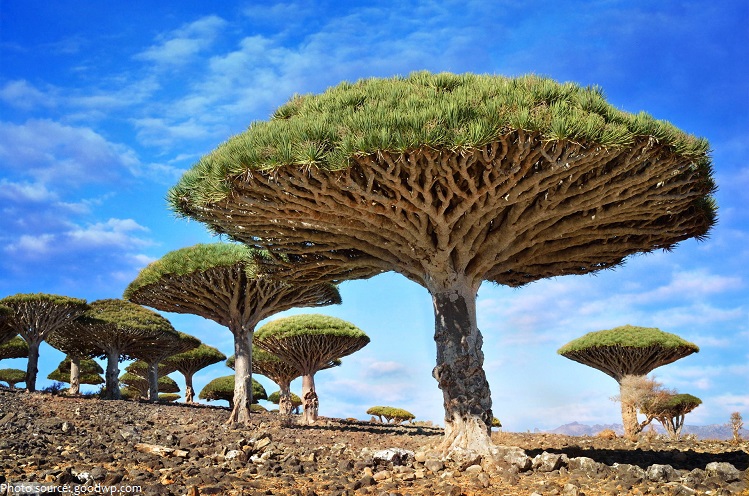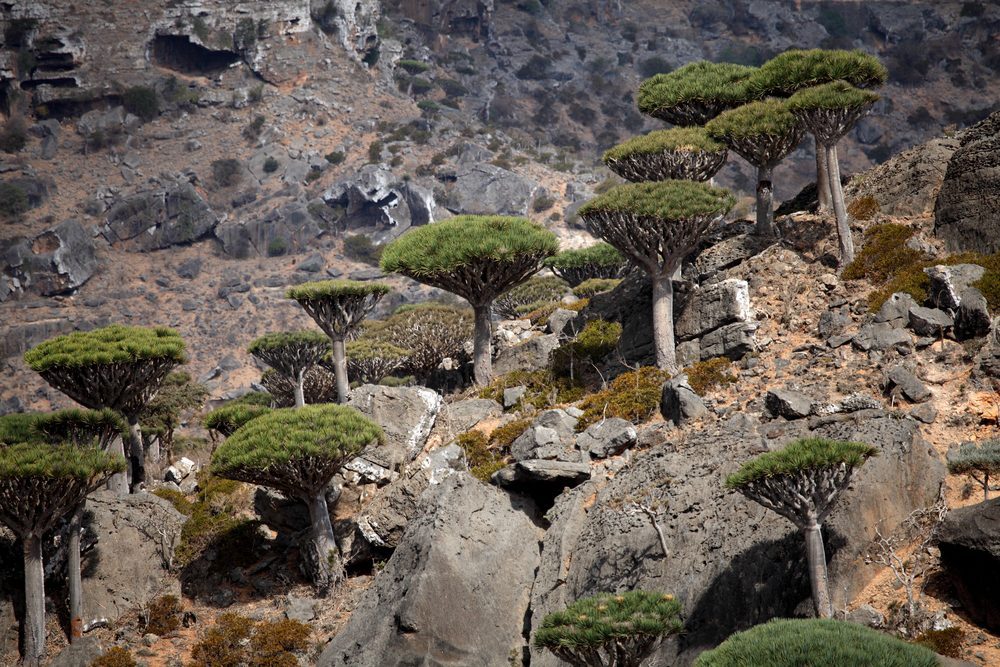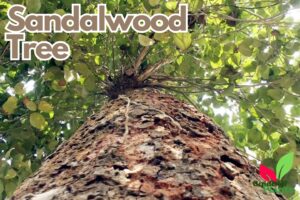The Dragon’s Blood Tree is an exotic and mysterious plant species found only on the island of Socotra off the coast of Yemen. With its umbrella-shaped canopy, bare trunk, and crimson sap, the Dragon’s Blood Tree has captivated people throughout history. This article will take a closer look at the biology and origins of this iconic tree, from its climate adaptations to growth patterns and life cycle. We’ll also explore some of the legends and symbolism associated with the Dragon’s Blood Tree on Socotra.
Table of Contents
Scientific Profile of the Dragon’s Blood Tree
The Dragon’s Blood Tree has the scientific name Dracaena Cinnabari and is part of the agave family. Its distinctive shape consists of branches that grow upright at first and then curve outward and flatten to form the umbrella canopy. The trunk and branches lack leaves and contain photosynthetic chlorophyll underneath the bark. When damaged, the Dracaena Cinnabari bleeds a dark red sap full of protective properties, hence the common name.
Also Know About: The Silk Floss Tree, Nature’s Remarkable Gift To Life

Physical Characteristics
Standing up to 33 feet tall, the Dragon’s Blood Tree has an otherworldly appearance. The bare trunk divides into several thick branches near the top, which arch upward before cascading downward. Small clusters of white flowers bloom directly from the branches, eventually forming berry-like fruits. The roots penetrate deep into the ground searching for moisture.
Resin Production
One of the most fascinating features of the Dragon’s Blood Tree is the blood-colored resin. This sap oozes out from cracks or cuts in the bark and has astringent and antibacterial properties. Scientists are studying the medicinal uses of the dragon’s blood resin.
Life Cycle
Dragon’s Blood Trees are very slow growing, but can live for 650 years or more. The seedlings initially form a low, dense rosette of leaves which drops as the tree matures. Gradually the bare, umbrella-shaped canopy develops.
Growth Cycle and Lifespan
Dragon’s Blood Trees follow a very long growth cycle in order to reach maturity. The trees sprout from seeds and spend 10 to 15 years developing a rosette of leaves and a taproot. It takes over 50 years before the canopy starts spreading upward. By 100 years, the trunk is visible and branching occurs. By 300 years old, the Dragon’s Blood Tree reaches its full height, with the umbrella canopy spreading wide. Its impressive lifespan exceeds 650 years in ideal conditions.
Adaptations to Arid Climate
Native to Socotra’s hot, dry climate, Dragon’s Blood Trees have adapted in several ways:
- Water storage – The thick trunk and roots store water for long periods of drought.
- Seed dispersal – The berry-like fruits are eaten by birds who spread the seeds through their droppings.
- Heat tolerance – Shedding the leaves prevents water loss through transpiration. The bare branches have high heat tolerance.
- Drought resistance -Taproot reaches deep underground to access moisture. Dense wood minimizes water loss.
The Dracaena Cinnabari‘s unique shape and adaptations allow it to thrive in Socotra’s harsh desert environment. The resilient tree continues to stand as a testament to evolutionary survival.
Unique Adaptations and Features of the Dragon’s Blood Tree
The Dracaena Cinnabari possesses several distinctive adaptations and features that make it stand out in the plant world. These evolutionary traits have enabled it to survive and thrive in Socotra’s challenging habitat.

Umbrella Canopy
The most recognizable feature of the Dracaena Cinnabari is its umbrella-shaped canopy. The branches grow upright and then bend downward in an opening cascade. This allows maximum light exposure while providing shade and cooler temperatures underneath. The broad, flatten branches also collect moisture from ocean mists and fog.
Blood-Colored Resin
When the bark is damaged, the Dragon’s Blood Tree secretes a dark red resin. This sap has anti-bacterial and astringent properties that protect the tree from insects and infection. The blood-red coloration may serve as a visual warning to deter predators. For centuries, the dragon’s blood resin was used as a dye, medicine, and varnish.
Longevity
Dragon’s Blood Trees are extraordinarily long-lived, with lifespans over 650 years. Their slow growth habit allows them to invest resources in strong, resilient tissues. The extensive root system draws moisture from deep underground. These traits enable the trees to survive Socotra’s harsh droughts and high temperatures.
Drought Resistance
With its minimal leaf surface area, tapped moisture sources, and minimized water loss, the Dracaena Cinnabari exhibits remarkable drought resistance. It can withstand extended periods of low rainfall and high evaporation that would kill off most other vegetation.
Evolutionary Adaptations
Scientists theorize that the unusual shape of Dragon’s Blood Trees evolved as an adaptive solution to hot, arid conditions. The umbrella canopy maximizes light exposure while providing shade for the bare trunk. Shedding leaves reduced transpiration. These specialized traits give the tree an evolutionary advantage in its native habitat.
The Dragon’s Blood Tree’s distinctive features reveal innovative evolutionary adaptations to a challenging environment. These characteristics make it uniquely suited to thrive in Socotra’s desert climate.
Also Know About: The Strangler Fig Plant A Wonderful Creation Nature

Ecology and Habitat of the Dragon’s Blood Tree
The Dragon’s Blood Tree inhabits a very specific ecological niche and environment. Understanding its habitat provides insights into its biology and conservation.
- Native Habitat: Dragon’s Blood Trees grow exclusively on Socotra, a small archipelago off the coast of Yemen. Socotra has an arid tropical climate with high temperatures year-round. Rainfall averages 15 inches annually. The island’s isolation led to highly endemic flora and fauna.
- Climate Conditions: Socotra’s climate is classified as subtropical dry broadleaf forest. It experiences little seasonal variation in temperature, which averages 86°F. Cyclones occasionally strike the island. The trees are well-adapted to periodic drought.
- Ecosystem Role: Dragon’s Blood Trees play several roles in Socotra’s ecosystem. Their canopies provide shade habitat and nesting sites. Fallen leaves enrich the soil. Resin helps heal wounds in the bark. The trees prevent erosion on mountain slopes.
- Symbiotic Relationships: Dragon’s Blood Trees rely on symbiotic relationships with other organisms. Lizards and birds serve as pollinators. Birds and bats disperse the seeds. Insects aid in decomposition and soil nutrient cycling. Mycorrhizal fungi associate with the roots to aid water and mineral absorption.
- Reproduction and Propagation: Dragon’s Blood Trees usually reproduce from seeds. The seeds germinate rapidly after cyclone rains. Trees reach maturity and begin flowering around 30-40 years old. They are propagated by rooted cuttings in botanic gardens.
- Growing Range: These trees are endemic to Socotra and some parts of Yemen and Oman. Attempts have been made to cultivate them outside this narrow range, but they evolved to thrive only in the specific conditions found on Socotra. Their limited habitat makes them highly vulnerable to extinction.
The intricate ecology of Dragon’s Blood Trees provides insights into their unique biological adaptations and need for careful conservation. Maintaining the integrity of their native ecosystem is crucial for their survival.
Dragon’s Blood Tree Lore and Legend
In addition to its biological mysteries, the Dracaena Cinnabari features prominently in the folklore and cultural heritage of Socotra.
Local Folklore and Beliefs
According to Socotri folklore, the dragon’s blood resin has mystical protective powers. The trees are considered ancient guardians of the island. Mythology ties them to dragons and serpents from which their sap originated. The crimson resin is thought to cure illnesses.
Dragon’s Blood Properties
Legends attribute near-mystical properties to the blood-red sap. As early as the Ancient Greek period, dragon’s blood was used as a dye, medicine, and incense. Many cultures prized it for alleged magical powers. The vivid coloration led to connections with dragons and dragon’s blood.
Prominence in Regional Lore
The Dragon’s Blood Tree is intertwined with traditional stories and poetry of the Socotra people. It is mentioned in everything from epic tales of heroes to love songs. References to its protective powers and connection to dragons abound.
Also Know About: Heliconia Psittacorum: Nature’s Most Unique & Beautiful Gift
Symbolic Ties
This iconic tree has become a powerful symbol of Socotra. Its image adorns the island’s flag and coat of arms as a representation of the unique flora. The Dracaena Cinnabari is a source of local pride and cultural identity.
Usage in Iconography
In addition to the flag and emblem, the Dragon’s Blood Tree is depicted on Socotri currency, postage stamps, and handicrafts. It serves as a recognizable icon representing the island’s singular ecology.
Tourism Draw
Visitors flock to Socotra to catch a glimpse of the majestic Dragon’s Blood Trees. Guided ecotourism brings in revenue while educating people about protecting the fragile population. The trees have great scenic and cultural value.
The Dracaena Cinnabari remains cloaked in mystique, forming an integral part of Socotra’s cultural identity, folklore, and appeal for centuries. Its rich legends contribute to its aura as an ancient, mythical plant.

Conservation of the Dragon’s Blood Tree
Due to its small native habitat and threats to its survival, focused conservation efforts are crucial for preserving the Dragon’s Blood Tree.
Major Threats
The major threats endangering the Dracaena Cinnabari include climate change, grazing livestock, invasive species, and infrastructure development. Prolonged droughts have led to failed regeneration. Goats eat young saplings, preventing maturity. Introduced species outcompete native plants. New roads and buildings fragment its habitat.
Declining Population
It is estimated only around 500 mature Dragon’s Blood Trees remain. The population is declining due to reduced rainfall and lack of juvenile trees reaching maturity. Urgent action is required to prevent extinction.
Protected Status
The Dracaena Cinnabari is classified as vulnerable on the IUCN Red List. Socotra was designated a UNESCO World Heritage Site in 2008. Legal protections aim to conserve both the trees and their island ecosystem.
Preservation Efforts
Conservation groups are working to propagate saplings, control invasive species, and raise awareness. Protected areas limit development near the trees. Involvement of local communities ensures traditional livelihoods align with sustainability.
Botanic Cultivation
Botanic gardens worldwide have attempted to grow Dragon’s Blood Trees outside their native range. This guards against complete extinction. However, the trees rely on Socotra unique
Ecotourism Potential
Carefully managed ecotourism offers hope for sustainable development on Socotra. Visitors generate income while learning about conservation. But tourism must be controlled to avoid damaging the fragile environment.
Saving the rare Dragon’s Blood Tree requires ongoing preservation efforts on Socotra combined with ex-situ botanic cultivation. Its allure makes it a poster child for endangered species conservation.
Also Know About: Nepenthes Alata, Nature’s Old Secrets of The Carnivorous Adaptation

Conclusion
The Dragon’s Blood Tree is truly one of the most unique and fascinating organisms on Earth. As outlined in this article, its exotic shape and adaptations allow it to thrive in Socotra’s harsh climate. The crimson resin, slow growth, and impressive longevity add to its biological mystique. Beyond its scientific intrigue, the Dragon’s Blood Tree has captured people’s imaginations across cultures and through time.
The prominent role of the Dracaena Cinnabari in Socotri legends and culture demonstrates its symbolic significance and cultural value. Tales of its mystical powers and connection to dragons persist and contribute to its allure as a mythical plant. Its depiction on Socotra’s flag and emblem speaks to its identity as a national treasure.
Sadly, only around 500 mature specimens of this iconic tree remain. Urgent conservation action is needed to prevent the extinction of the Dracaena Cinnabari in the wild. Protecting its fragile island habitat and propagating saplings will require coordinated international efforts. Saving this unique species would ensure future generations can still experience its enduring mystique and majesty.
The Dragon’s Blood Tree remains one of the botanical wonders of our world. This singular plant encapsulates the mystery and fragility of Socotra’s remarkable ecosystem. With care and stewardship of our shared natural heritage, we can help guarantee this ancient treasure continues inspiring awe for centuries to come.




